12 Japandi Furniture Picks with Room-by-Room Selection Tips
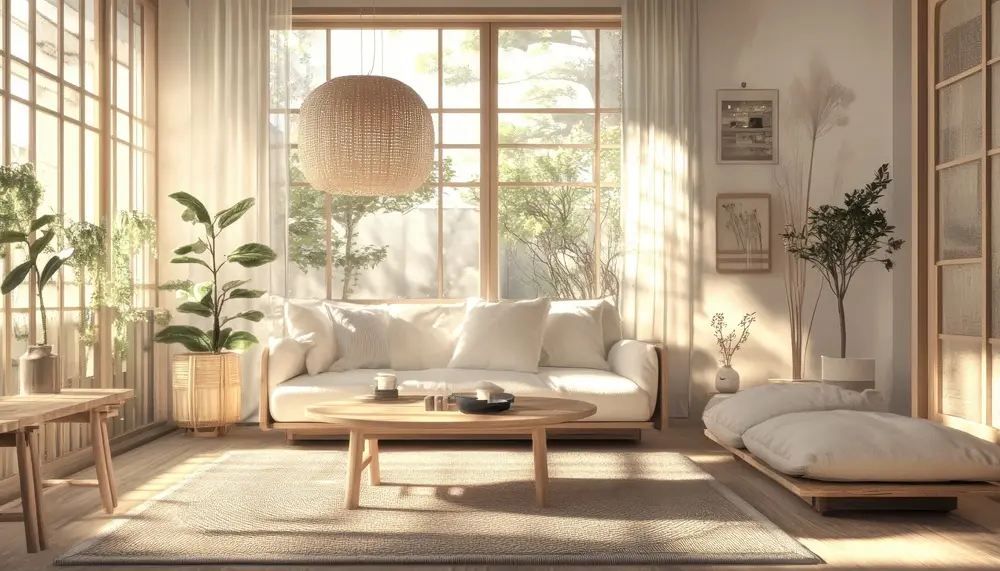
Japandi style is the art of combining Japanese minimalism with Scandinavian warmth, emphasizing simplicity, natural materials, and functionality, resulting in homes that feel serene, cozy, and balanced. Furniture plays a central role in achieving this aesthetic, shaping both the look and feel of a home. Thoughtfully selected pieces provide comfort, support daily routines, and guide the flow of movement, while also creating a sense of harmony, balance, and calm.
In a Japandi home, every sofa, table, and chair contributes to a serene, cohesive environment where both living and entertaining feel effortless. This guide introduces 12 essential Japandi furniture types and offers practical, room-by-room tips to help you design a calming and stylish interior.
What is Japandi Furniture?
Japandi furniture reflects a philosophy of understated elegance. Unlike purely decorative trends, it focuses on functionality, quality craftsmanship, and longevity. Common features include clean lines, muted colors, and natural materials such as wood, bamboo, and linen. The goal is to create a living space that feels open, airy, and uncluttered while maintaining a sense of warmth and comfort.
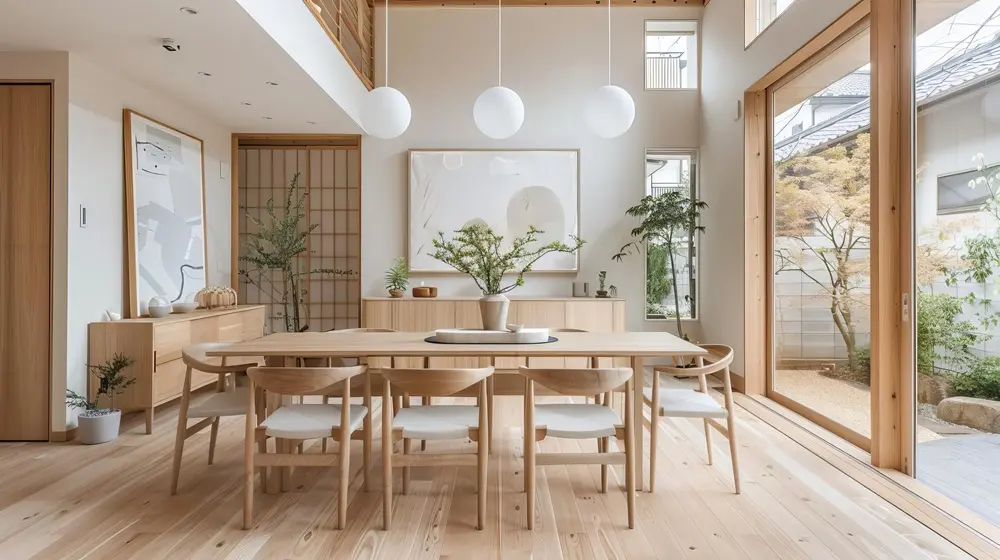
For a deeper dive into Japandi principles, visit the Japandi Design Guide.
Japandi Furniture: Key Features
Japandi furniture can be distinguished by its materials, colors, forms, and design philosophy. Materials like natural wood, linen, bamboo, and rattan bring texture and tactile warmth into a space. Color palettes tend to be neutral and earthy such as soft beige and muted gray hues. Natural wood tones dominate, creating a calm backdrop for everyday life. Form focuses on minimalism with clean lines and functionality at the forefront; each piece is designed to be beautiful without being excessive. At its core, Japandi style embraces wabi-sabi — the beauty found in imperfection and the quiet value of handcraft, while balancing it with the Scandinavian concept of hygge, which celebrates comfort, warmth, and the joy of everyday living.
How to Choose Japandi Furniture by Room
Choosing the right Japandi furniture is about more than just aesthetics. It requires considering the function of each room, the flow of movement, and how furniture interacts with natural light and space. Thoughtful placement ensures a sense of harmony and space, which is central to Japandi design. Below is a room-by-room guide to 12 essential furniture types, highlighting where they work best and tips for selection and arrangement.
1. Japandi Sofa
The sofa is often the centerpiece of a living room, and in Japandi interiors, it balances simplicity with comfort. Low-profile sofas with wooden legs and neutral-colored upholstery help maintain visual openness while providing a cozy seating area. In addition to the living room, Japandi sofas can create inviting reading nooks or function as daybeds in bedrooms. For smaller spaces, consider pairing a compact sofa with a single-seater armchair or easy chair to maintain harmony without crowding the room. Adding a linen throw or soft cushions in earthy tones can enhance hygge comfort without disturbing the minimalist aesthetic.
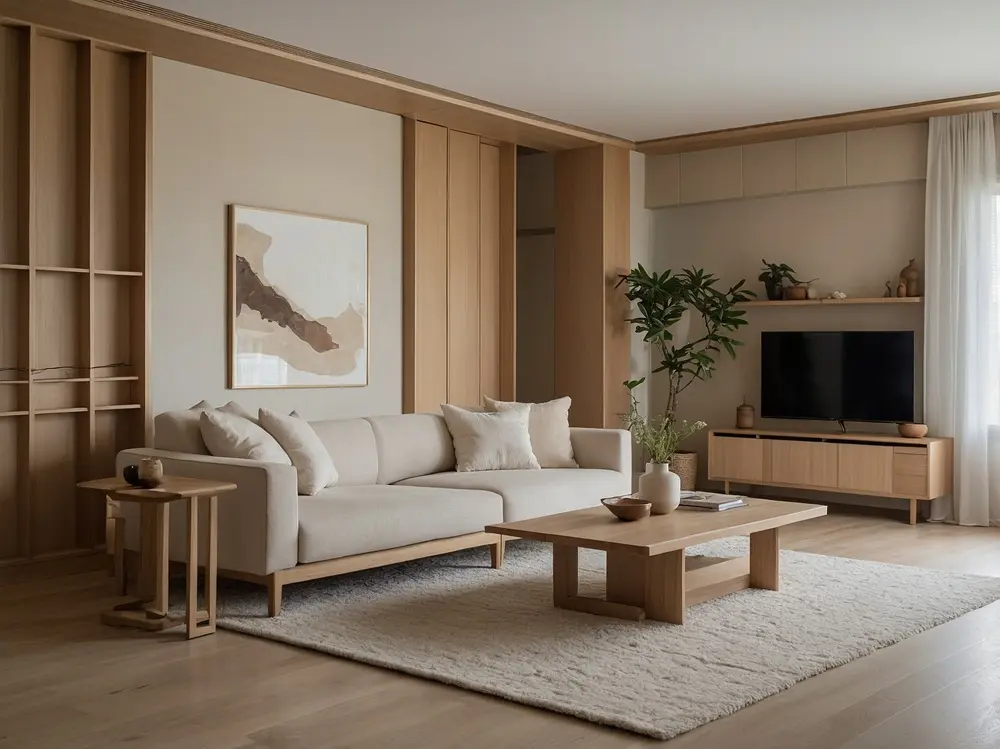
2. Japandi Coffee Table
Coffee tables are more than just functional surfaces, they anchor a seating area. In Japandi interiors, they are typically made from natural wood and showcase simple geometric shapes. Round or oval tables promote a smoother flow, especially in smaller living rooms, while rectangular tables suit larger, open-plan spaces. If you choose materials such as water-resistant wood or artificial rattan, they are perfect for outdoor or garden seating areas. These materials allow you to create a Japandi aesthetic that harmonizes with nature, blending simplicity, natural textures, and functionality. Choosing tables with subtle storage options can maintain clutter-free spaces while enhancing the clean-lined aesthetic.

Read more about Japandi coffee tables
3. Japandi Indoor Plants
Plants are essential in Japandi interiors, infusing rooms with life and softness. They work in virtually every space—from living rooms and dining areas to bedrooms, kitchens, and even powder rooms. Selecting plants with elegant, simple foliage complements the neutral Japandi palette, while pots in muted tones or natural materials keep the look cohesive. Indoor plants also contribute to a sense of hygge, adding calm, freshness, and a subtle connection to nature in each corner of your home.
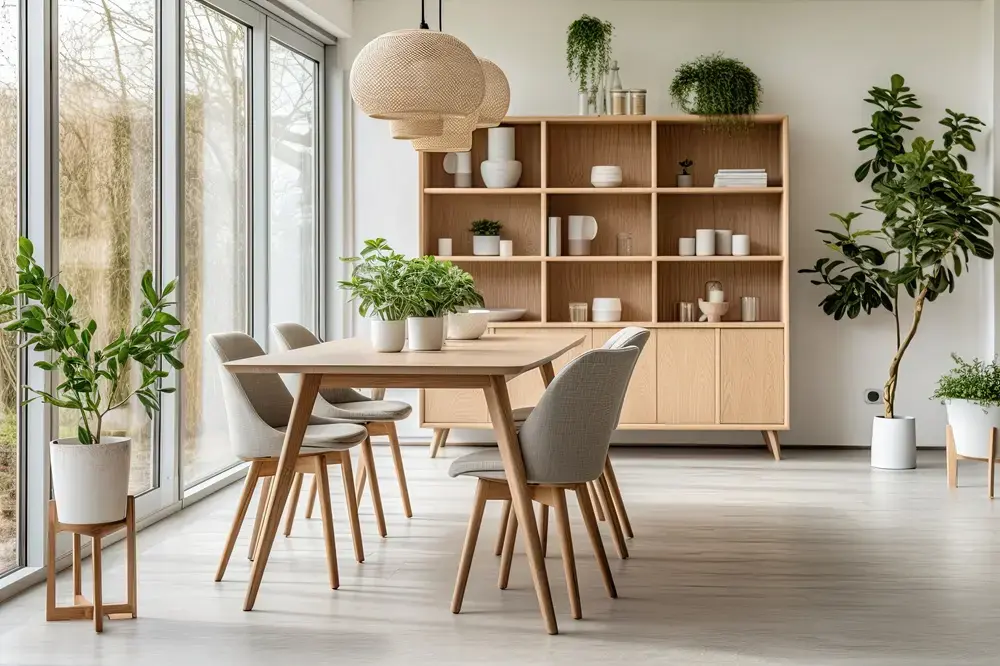
Read more about Japandi indoor plants
4. Japandi Lighting
Lighting in Japandi interiors balances function and atmosphere, using soft, warm illumination to enhance natural textures and create a serene mood. In the living and dining areas, a mix of main and indirect lighting casts gentle shadows, evoking a wabi-sabi sense of calm. Bedrooms feel soothing with wooden or washi paper bedside lamps that diffuse a soft glow, ideal for winding down. In bathrooms, simple fixtures with frosted or washi-style glass shades offer a tranquil, spa-like ambience. For terraces or gardens, subtle outdoor lighting should harmonize with wooden furniture and greenery, extending the home's quiet elegance into nature.

Read more about Japandi lighting
5. Japandi Chair
Chairs in Japandi design are versatile, sturdy, and elegant, typically crafted from natural materials such as wood, bamboo, rattan, or wooden planks. Cushions made from fabric or leather can be added for comfort, though simplicity is key. In the dining room, a set of clean-lined wooden chairs elevates the space without creating visual clutter. Accent chairs in living rooms or bedrooms provide additional seating while maintaining the minimalist aesthetic, and choosing pieces with simple, functional designs ensures both comfort and harmony with Japandi principles. For entryways, compact wooden or rattan chairs and benches work well without obstructing traffic flow, serving as subtle decoration while offering practical surfaces for bags, shoes, or potted plants — embodying the beauty of utility central to Japandi design.
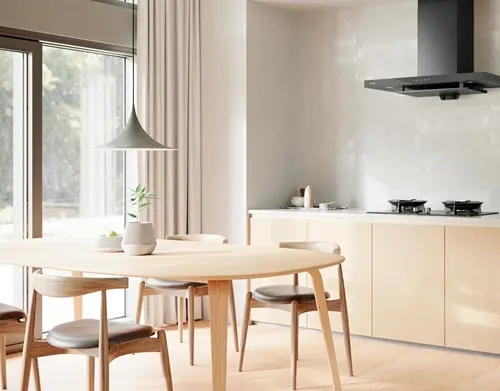
6. Japandi Beds
Beds are central to comfort and visual appeal. Japandi beds often feature low wooden frames with minimalist designs, blending perfectly with neutral linens. Daybeds or multi-functional beds are especially versatile, a simple Japandi-designed daybed in the living room or guest room harmonizes effortlessly with other furniture while doubling as a seating area. In kids' rooms, compact, multi-functional beds provide both practicality and a sense of openness. Choosing a solid wood frame with clean lines ensures durability and complements the overall aesthetic, while incorporating simple under-bed storage helps maintain the uncluttered, serene look that defines Japandi interiors. Opting for a daybed or multi-functional bed in a Japandi style combines style, versatility, and harmony, enhancing both function and the calm, cohesive atmosphere of the home.

Read more about Japandi bed frames
7. Japandi TV Stand
TV stands should be functional without dominating the space. In Japandi interiors, they typically feature clean, rectangular lines and hidden storage compartments for electronics and cables. They are ideal for living rooms, dining areas, or even bedrooms where media consumption is integrated into a serene, minimalist environment. Materials like light oak or walnut maintain a natural, warm tone that complements surrounding furniture.
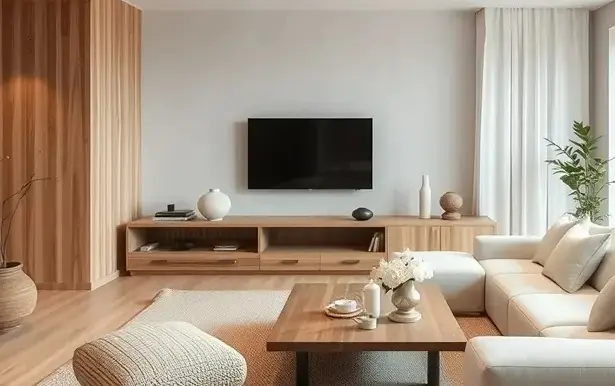
8. Japandi Storage
Storage solutions are critical in maintaining the uncluttered look central to Japandi design. Beyond large cabinets or sideboards, smaller storage items like baskets, boxes, and fabric organizers offer practical and stylish ways to keep spaces tidy. Fabric boxes are perfect for organizing toys, books, or personal items in a child's room, combining convenience with a soft, natural texture. Woven baskets serve both as functional storage in living rooms or bedrooms and as decorative accents that bring warmth and tactile interest to the space. Choosing simple, natural materials ensures these pieces harmonize with the overall Japandi aesthetic, supporting both order and understated beauty in every room.

9. Japandi Bookshelf
Bookshelves serve both practical and decorative purposes, with designs tailored to each room's function. In a child's room, open shelves make it easy for children to select and put away books, encouraging independence while maintaining order. In a study room, open shelving provides accessibility and a clear view of materials, supporting a focused and uncluttered workspace. For living or dining rooms, where entertaining may take place, a combination of open and closed shelves balances display and storage, keeping the space tidy while showcasing a curated selection of books. If you want to store a small, carefully chosen collection of books in any room, floating shelves allow for thoughtful displays of books, ceramics, or potted plants, creating a sense of calm, harmony, and understated beauty consistent with Japandi principles.
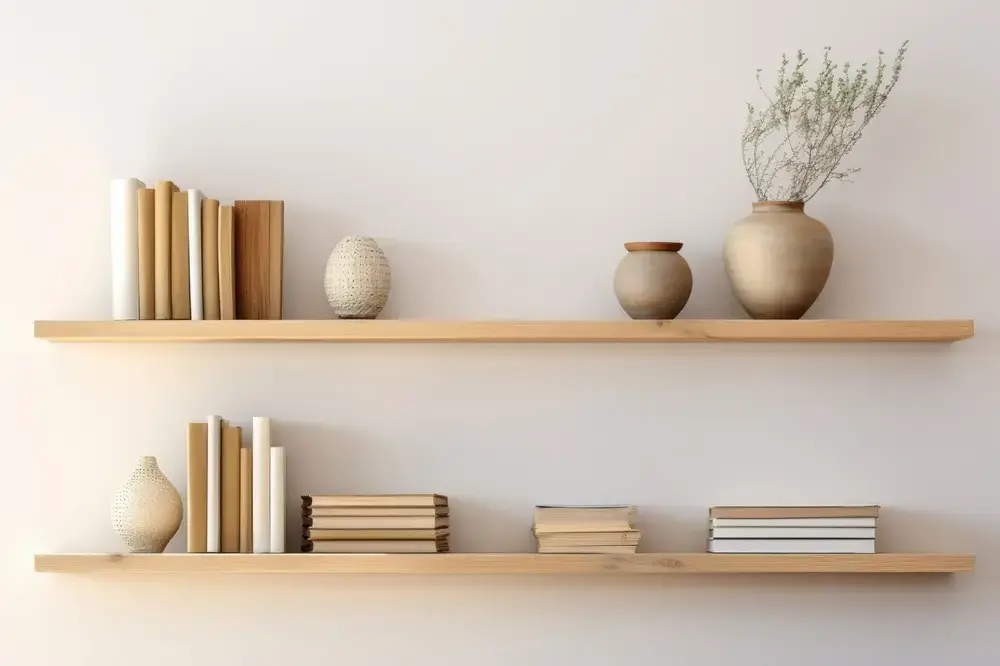
10. Japandi Desk
Desks are central to focus and productivity, particularly in bedrooms, study areas, or kids' rooms. Japandi desks are compact yet functional, often made from natural wood with minimalistic lines. In bedrooms, selecting a desk with materials and colors that harmonize with the bed frame helps create a cohesive and calming environment. In study areas, functionality is key, integrated drawers or shelving allow stationery and supplies to be neatly stored, maintaining a clutter-free workspace that supports concentration. In kids' rooms, desks should be practical and durable, with easy-to-access storage to encourage organization and independence. Across all locations, choosing simple, well-crafted desks ensures both visual harmony and everyday usability, reflecting the calm, balanced aesthetic central to Japandi design.

11. Japandi Stools
Stools are versatile accents in Japandi interiors, offering both functionality and style across different rooms. In bathrooms, compact wooden or rattan stools provide a practical spot for sitting or holding towels and toiletries, blending seamlessly with natural materials and maintaining a calm, uncluttered atmosphere. In kitchens, stools serve as casual seating at breakfast counters or islands, with minimalist wooden designs that complement cabinets and countertops while keeping the space airy. In living rooms, stools can act as additional seating or double as side tables for plants or decorative items, adding warmth and texture without overwhelming the room. By choosing simple, natural materials and clean lines, Japandi stools harmonize with surrounding furniture and contribute to the serene, balanced aesthetic central to the style.
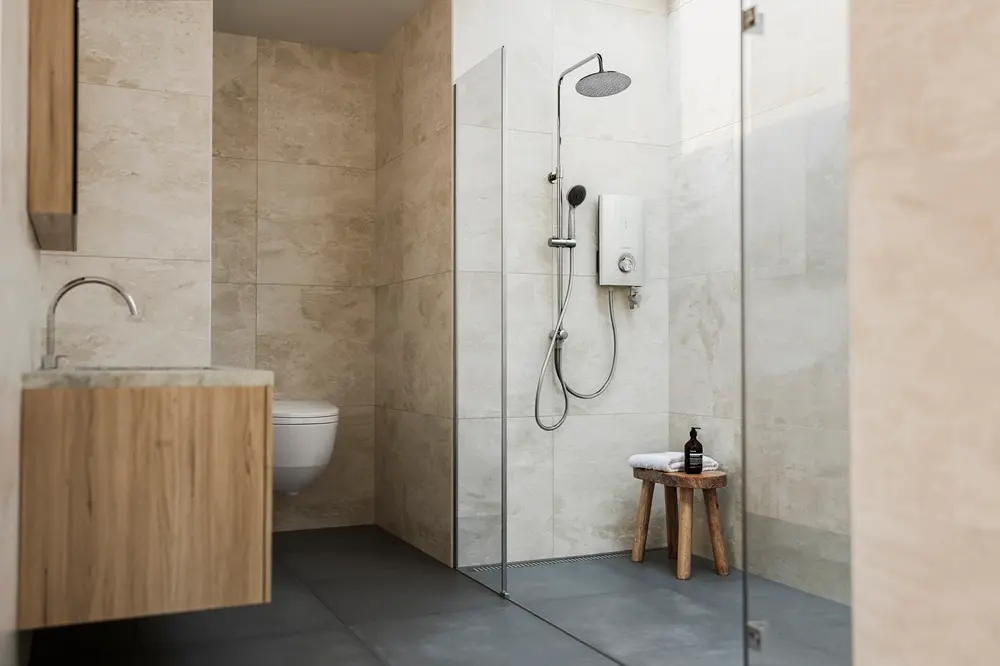
12. Japandi Sideboards
Sideboards offer both storage and display functionality. In living rooms or dining areas, they act as understated focal points, storing essentials while showcasing decorative pieces such as ceramics or art. To coordinate easily with other Japandi furniture, choose sideboards with natural wood tones that match or complement existing pieces, clean lines, and minimalist handles or hardware. Avoid overly ornate designs or contrasting finishes, as simplicity and harmony are key. Wooden sideboards with minimalist handles maintain cohesion with other furniture while supporting practical use in everyday life.

Creating a Serene and Cohesive Japandi Home
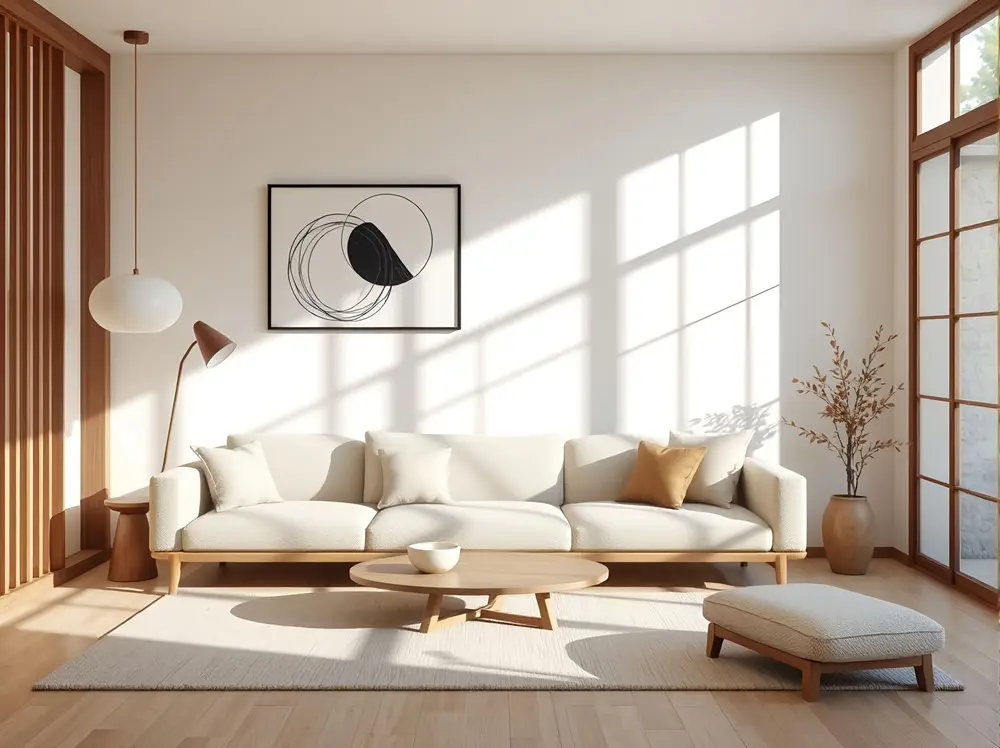
Japandi furniture emphasizes simplicity, functionality, and natural beauty. By carefully selecting pieces for each room and considering their placement, you can create a home that feels both serene and inviting. Each furniture type, from sofas to lighting, contributes to the understated elegance and warmth that define the Japandi lifestyle.
*Some of the images featured in this article were created using generative AI.

